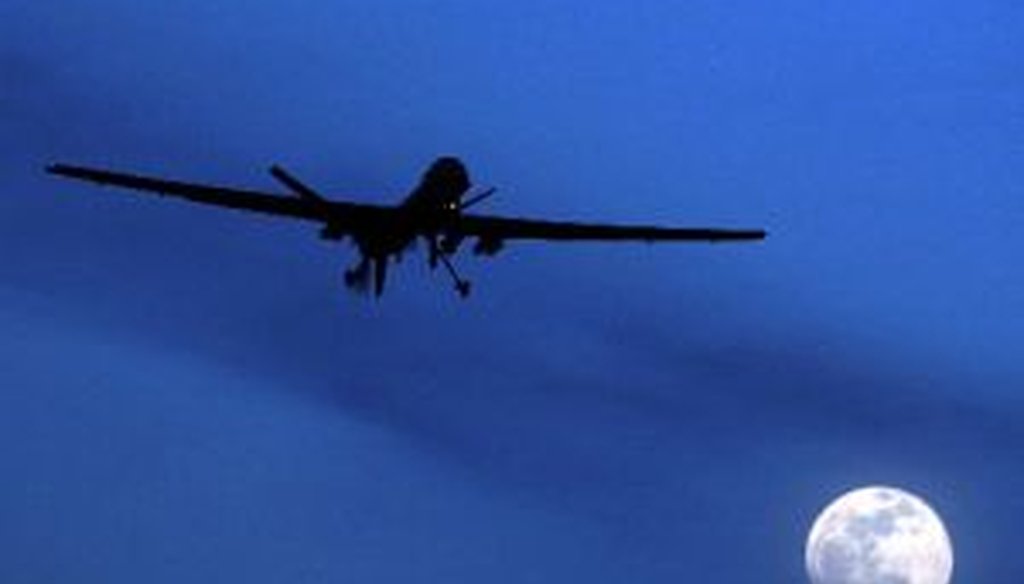



An unmanned United States Predator drone flies over Kandahar Air Field in Afghanistan on a moon-lit night in a Jan. 31, 2010, file photo.
In Hillary Clinton’s new memoir, Hard Choices, the former secretary of state defends the administration’s use of drone strikes in the face of knotty ethical and legal questions.
In chapter 9 of the book, Clinton says drone strikes quickly became "one of the most effective and controversial elements of the Obama Administration’s strategy against al Qaeda and like-minded terrorists."
She goes on to defend the careful planning of the strikes and their legal grounding, as well as their strategic value. But we were especially interested in one claim she made: "President Obama would eventually declassify many of the details of the program and explain his policies to the world, but in 2009 all I could say was ‘no comment’ whenever the subject came up. Yet it was widely known that dozens of senior terrorists had been taken off the battlefield by drones, and we later learned that bin Laden himself worried about the heavy losses that drones were inflicting."
Is that correct?
First, some background. Using armed unmanned aerial vehicles in combat is controversial because it pushes legal boundaries. (Here’s a previous fact-check in which we looked at this issue.) Of special concern is that drones have killed at least four American citizens on foreign soil.
In defense of the program, officials often praise its effectiveness in hampering terrorist organizations.
Tallying up the number of drone strikes is challenging, for obvious reasons -- they are done with tight secrecy. Although breaking down this data is difficult to do as a layperson, experts we checked with suggest that the claim that U.S. drone strikes have killed "dozens" of senior terrorists may well be an understatement.
"Hillary Clinton’s statement is 100 percent correct," said Daveed Gartenstein-Ross, a senior fellow at the Foundation for Defense of Democracies. "That’s a conservative estimate."
There are no definitive lists of drone strikes or casualties they cause, but an analysis by the New America Foundation, a think tank, found that as of 2013, drones have killed about 58 known militant leaders in Pakistan and 35 in Yemen. In just those two countries, drones have killed between 2,861 and 4,452 people in all -- civilians and unknowns, in addition to militants, according to the foundation’s study. (Pakistan and Yemen are the locations of the majority of United States drone strikes, though attacks have also occurred in Libya, Afghanistan, Iraq, Somalia and Philippines.)
Clinton, though, uses the "dozens" number to refer to senior terrorists killed through 2009. A look through another non-governmental database -- created by the Bureau of Investigative Journalism, a philanthropically funded investigative-journalism project based in the United Kingdom -- appears to provide support for Clinton’s claims.
We sifted through the project’s aggregated news reports about confirmed and suspected U.S. drone strikes in Pakistan, Yemen and Somalia, where the U.S. primarily sends drones to target members of al-Qaida and its affiliates. We searched for reported deaths of terrorists and militants described as "senior," "leader" or "commander" through the end of 2009.
Under these reasonably restrictive conditions, we found roughly three dozen top terrorists killed. Looking just at articles compiled by the Washington Post, we come up with at least two dozen.
This number is nowhere near definitive, since it includes several deaths that are disputed. On the other hand, the number could be higher since it doesn’t include information from unreported strikes or strikes in Afghanistan, Libya, Iraq or Philippines.
Despite these caveats, a conservative analysis of the evidence does suggest a factual basis for Clinton’s claim.
A final note: Clinton also appears to be right about bin Laden being concerned about drones.
A trove of letters found at Osama bin Laden’s compound after his 2011 death reveal that he was concerned about America’s drone use. In an October 2010 letter, he revealed that he was particularly worried about attacks in Waziristan, a region of Afghanistan.
"I am leaning toward getting most of the brothers out of the area," he wrote. "We could leave the cars because they are targeting cars now, but if we leave them, they will start focusing on houses and that would increase casualties among women and children. It is possible that they have photographed targeted homes. The brothers who can keep a low profile and take the necessary precautions should stay, but move to new houses on a cloudy day."
Our ruling
Clinton said that "dozens of senior terrorists had been taken off the battlefield" by drones. While it’s difficult to find a definitive number just using publicly available evidence, even a conservative estimate using credible accounts is enough to rate her claim True.
Hillary Clinton, Hard Choices, published June 10, 2014
Washington Post, "Everything you need to know about the drone debate," March 8, 2013
Washington Post, "Tracking America’s drone war," last updated Dec. 27, 3013
New York Times, "Recovered Bin Laden Letters Show a Divided Al Qaeda," May 3, 2012
Brookings Institution, "Deadly Drone Strike on Muslims in the Southern Philippines," March 5, 2012
New America Foundation, National Security Program findings, accessed June 10, 2014
Bureau of Investigative Journalism, Get the data: drone wars, accessed June 10, 2014
Combatting Terrorism Center at West Point, "Letters from Abbottabad: Bin Laden Sidelined?" May 3, 2012
Letter from Osama bin Laden to Shaykh Mahmud, Oct. 21, 2010
Phone interview, Daveed Gartenstein-Ross, Foundation for Defense of Democracies senior fellow, June 10, 2014
In a world of wild talk and fake news, help us stand up for the facts.
